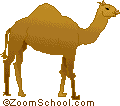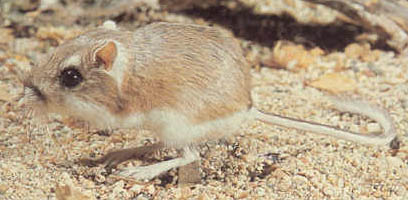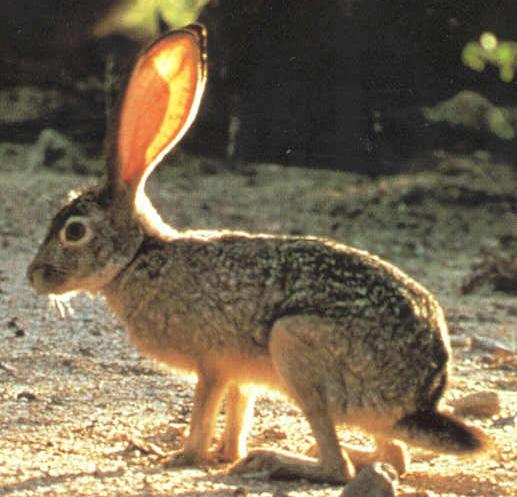Home | Overview | Lesson One | Lesson Two | Lesson 3 | Lesson 4 | Lesson 5
Animal Database | Assessments | Desert Causes Database | Desert People
Plant Adaptation Database | Terrain Database | Vocabulary Database
AIMS:
1. What are some desert animals?
2. What are desert animal
adaptations?
MOTIVATION:
Brainstorm with students about what desert
animals they are familiar with. After they have named a few, have them
link to http://enchantedlearning.com/biomes/desert/desert.shtml . At this site they can find
information about hundreds of desert animals from all around the world.
PROCEDURE:
1. The students can work in pairs for
the following activity. They are to link to http://enchantedlearning.com/biomes and choose an animal that they
are interested in. They are to click on that animal and will go to an
animal printout page. They are to read the facts about the animal and note
which desert the animal lives in and other facts. They are to color the
animal printout. The following is a few examples of the animal printouts from
the site:
2. When the class is finished, they
can put their printouts into a class "Desert Animal" book. This can also
be done individually.
3. Review the harsh climatic
conditions of the desert that the children learned about in previous lessons.
What conditions do the animals of the desert have to adapt to? Children
should be able to give you: lack of water, extremes in temperature, sandy
ground, sandstorms, etc.
4. Choose in advance, a number of
desert animals that have very clear adaptations. Children will fill in a
database with the animal's name and picture and research their adaptations.
They can get their information from the following sites: http://enchantedlearning.com/biomes and http://library.thinkquest.org/28855/lizards.html Their adaptations
should include all the ways the animal survive in the desert. The
following is for teacher use. For a student's copy click here.
ILLUSTRATION AND ANIMAL
NAME |
ADAPTATION |
 Arabian Camel Arabian Camel |
Camels have nostrils that can open and
close, protecting them from the desert environment. Bushy eyebrows and two
rows of long eyelashes protect their eyes from sand. Their mouth is
extremely tough, allowing camels to eat thorny desert plants. The camel's
hump contains fat (and NOT water). The camel can go without food and water
for 3 to 4 days. It is well adapted to desert life. They have twin-toed
webbed feet to prevent sinking into the sand.
|

Kangaroo Rat |
The bigger kinds of
kangaroo rats which live in the driest, hottest heart of the desert never
drink! It is because of its body is redesigned to perform a chemical
miracle--by just nibbling on dry seeds and dead stems, it can survive. |
 Fennec Fox Fennec Fox |
Both of the foxes have
developed gigantic ears which allow them to hear very well. With
their good hearing, they can hunt more easily for prey. The ears also help
them to stay cool on hot afternoons.
Both kit fox and the Fennec fox have a
sandy-colored coat to provide camouflage in the desert. This makes them
safer as their predators cannot see them so easily among the sand.
|
 Gila Monster Gila Monster |
As it is so hot in the desert, a
beautiful piece of natural insulation covers its body, so it makes the
monster sun-proof. |

Jack Rabbit |
Jackrabbits have large, long ears that
act as radiators to help them keep cool.
At twilight, when it is cooler, jackrabbits come out
to look for food. Their main diet, yucca plants and cacti, have so much
moisture in them that jackrabbits don't have to drink water if they eat
enough food.
Jackrabbits have found out a special way to eat
cacti without getting pricked by the spines. First, they nibble around the
spines. Then, when the spines fall out, they can eat the flesh inside. |
 Rattlesnake Rattlesnake |
Rattlesnakes hunt at night when it is
cooler to avoid the heat of the day. Their rattle scares other
predators away. |
 Roadrunner Roadrunner |
Roadrunners have a special way to save
energy. They become torpid on cold nights. That means it does not move or
feel anything at all, and it is like hibernating for one night. When they
wake up in the morning, they bask in the sun to warm up. In this way they do
not have to use up a lot of energy to keep warm at night |
 Scorpion Scorpion |
Out of all desert animals, scorpions
are probably best adapted to desert life. They can bear higher temperatures
than any insect or spider, and they have the lowest water-loss rate in the
desert. They can even go without water for a few months and survive without
food for more than a year! Scorpions are almost totally nocturnal creatures.
In the daytime, they usually hide in large, cool, damp underground burrows.
Some bury themselves in shallow holes or loose sand, or hide under rocks and
plants. At night, they come out to hunt for food. |
ASSESSMENT:
After students have learned about
the various adaptations of desert animals, have them create their own desert
"creature". They are to include a written description, the animal's
adaptations, and draw a picture of their animal.
FOLLOW-UP: This lesson will lead into the last lesson "Who are some
desert people?"
|